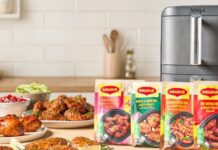Healthy ingredients are good for well-being and for the environment – that’s how you could describe the mood among consumers in the food and beverage sector. The fact is that, partly due to the pandemic, consumers are increasingly on the lookout for healthy products and changing their consumption habits in favor of free-from and clean-label products. The question of personal well-being is becoming more and more of an everyday topic. These changes in consumers’ desires can also be seen by the beverage and liquid food industry, which will meet from 12 to 16 September at the world’s leading trade fair drinktec in Munich.
Little or no sugar
Consumers want products with less sugar: Manufacturers of beverages and liquid foods deliver. According to market research company Mintel, the top-3 countries for the product launch of reduced-sugar and sugar-free beverages in the last five years were Great Britain (15 %), closely followed by Germany (13 %) and France (10 %). “France and Germany were among the five European countries with the most patents aimed at reducing sugar content, with each accounting for five percent of the world’s patents,” explains Neha Srivastava, Food & Drink patent analyst at Mintel. “These patents are related to improving the taste of sweeteners and developing technologies that reduce the costs of manufacturing alternative kinds of sugar.”
Little to no alcohol
There has been a distinct rise in demand for NOLO beverages (no and low alcohol) in the last two years. A study of the British market, for example, recorded a 32.5 percent increase in the consumption of NOLO beverages during the first lockdown in 2020.
Gins and aperitifs with 0% alcohol by volume—in other words products that can’t be called spirits—show that consumers’ awareness of health also demands new approaches in the world of drinks and cocktails. But it isn’t necessarily any easier to produce these drinks. For example, it takes a timespan of six weeks to combine the desired flavor from the complex mix of herbs, spices and peels in order to produce the distilled, alcohol-free product Seedlip.
Juice and smoothies
It goes without saying that juice-based products also offer potential in this context. According to Statista, global sales in the “Other juice, juice mixes and smoothies” segment will be around Euro 38 billion (approximately Rs 3,08,527 crore) in 2022. A market volume of Euro 45 billion (approximately Rs 3,65,361 crore) is expected by 2026, an annual growth rate of 4.41 percent. In terms of quantity, the market volume is predicted to comprise 16 billion liters in 2026. The US market is particularly interesting, with a sales volume of Euro 5 billion (approximately Rs 40,595 crore) expected there in 2022.
Inspiration and technology for new products
The world’s leading trade fair drinktec in Munich provides all manufacturers of beverages and liquid food the right impulse for creating new products. Manufacturers of ingredients and process technology are sources of inspiration with their plant-based beverage innovations, reduced sugar content and sugar substitutes as well as functional plant-based components.
The ingenuity of the industry remains high. Technologies for beverages and liquid food are definitely still in their infancy when it comes to unlocking the potential of plant-based products. Last but not least, due to changes in supply chains, the testing, development, search for and discovery of alternative product compositions will be intensified in future. A cold brew coffee from the US shows what is possible – Through reverse engineering, the start-up Atomo has developed a molecular coffee—without a single coffee bean.
With the development of methods for extracting vitamins or proteins from the residual materials from traditional beverage production, several companies are showing what development potential is still waiting to be unlocked.
This doesn’t stop at the idea for a new beverage creation – For manufactures who are now making their way from spirits to the non-alcoholic segment, for example, there are a few challenges to overcome. To develop non-alcoholic beverage variants in the spirits family, they have to be completely rethought without the alcoholic component if you want to bring a product with an appropriate storage life onto the market.
For that reason the trade fair areas for process technology and filling are of course the first ports of call for visitors wanting to get started with new beverage ideas. They can put their concept to the test with the exhibitors at drinktec. For example:
- Do new process technologies and product preparation strategies need to be pursued?
- Are there microbial requirements when it comes to the product specifications?
- What demands does the new beverage place on the filling technology?
One thing is clear – there are many options in these product innovation programs. In some cases, small additions to the system will be sufficient to produce the new product creations. In others, the market potential or the status quo in production will require a completely new line or—in a third scenario—a completely new production plant.
New beverage concepts—platform for new beverage creations
Inspiration for new beverages is pooled together and easy to find in Hall A5 – The special show New Beverage Concepts offers an excellent platform for people gathering ideas with an open design concept. Product developers, brands or innovation managers as well as buyers can find out about new sweetening concepts, colorings, flavors, ingredients, treatments and additives from the suppliers here. With a tasting zone, the concepts are not only subjected to a dry run, but are also to initial taste tests directly on site. With this format, trade fair visitors will receive comprehensive inspiration that will appeal to new groups of buyers.
IndiFoodBev — authentic, impactful and influential
An English-language food and beverage processing and packaging industry B2B platform in print and web, IndiFoodBev is in its third year of publication. It is said that the Indian food and beverage industries represent approximately US$ 900 billion in revenues which implies more than 20% of the country’s GDP. Eliminating the wastage on the farmside can help to deliver more protein to a higher number of the population apart from generating sizable exports. The savings in soil, seeds, water, fertilizer, energy and ultimately food and nutrition could be the most immense contribution that country is poised to make to the moderation of climate change.
To improve your marketing and grow sales to the food and beverage processing and packaging industry, talk to us. Our research and consulting company IppStar [www.ippstar.org] can assess your potential and addressable markets in light of the competition. We can discuss marketing, communication, and sales strategies for market entry and growth.
Suppliers and service providers with a strategy and budget for targeted marketing can discuss using our hybrid print, web, video, and social media channels to create brand recognition linked to market relevance. Our technical writers are ready to meet you and your customers for content.
The second largest producer of fruit and vegetables in the world is continuously expanding processing capacities and delivery systems with appropriate innovative technologies. We cover product and consumer trends, nutrition, processing, research, equipment and packaging from farm to thali. Get our 2025 media kit and recalibrate your role in this dynamic market. Enhance your visibility and relevance to existing markets and turn potential customers into conversations. Ask for a sample copy of our bi-monthly in print or our weekly IndiFoodBev eZine each Wednesday.
For editorial info@ippgroup.in — for advertisement ads1@ippgroup.in and for subscriptions subscription@ippgroup.in
Naresh Khanna – 10 February 2025
Subscribe Now











